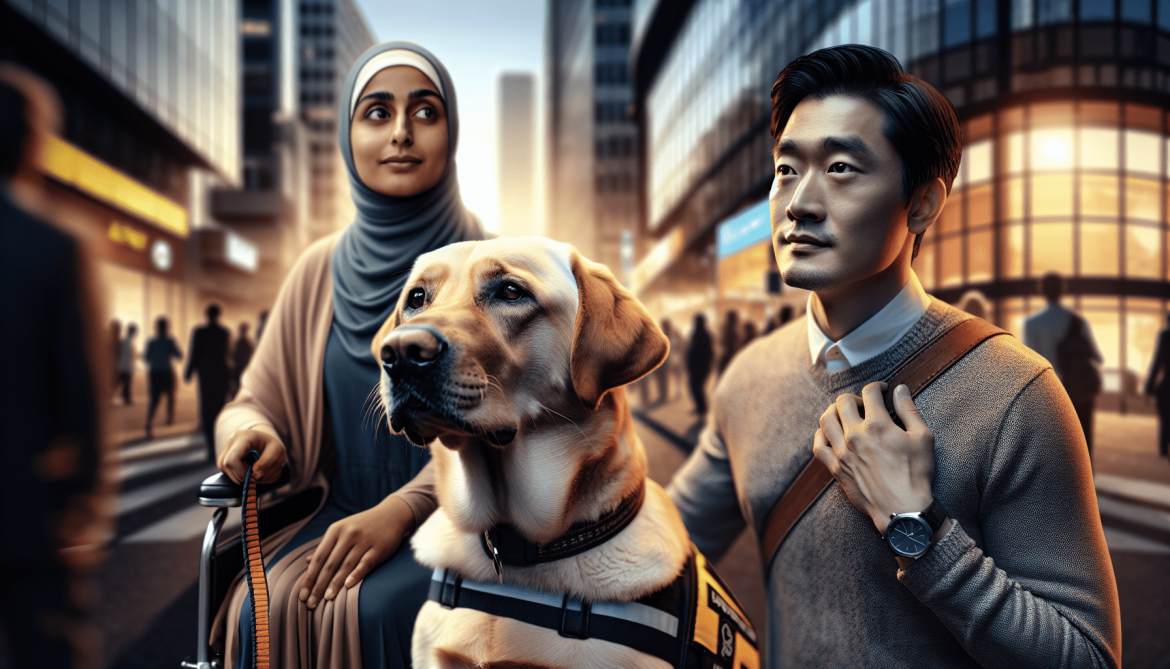If you've ever wondered how to take your dog's training to the next level and potentially help others in the process, then advanced dog training for service animal certification might be the perfect path for you. With this specialized training, you can equip yourself with the knowledge and skills necessary to train dogs for various service roles, such as guiding the visually impaired or providing emotional support to those in need. Whether you're a dog enthusiast looking for a new challenge or someone seeking a fulfilling way to make a difference, advanced dog training for service animal certification holds the key to a rewarding journey of learning and compassion. So, grab your leash, put on your training hat, and let's embark on an adventure that will transform both you and your furry friend's lives!

This image is property of images.pexels.com.
Benefits of Advanced Dog Training
Enhances the dog's abilities and skills
Advanced dog training goes beyond basic obedience commands and allows dogs to develop their natural abilities and skills. Whether it's scent detection, search and rescue, or mobility assistance tasks, advanced training helps dogs reach their full potential. By honing their talents, dogs become more confident and capable in performing their designated tasks.
Improves obedience and reliability
One of the key benefits of advanced dog training is the improvement of obedience and reliability. Advanced training builds upon the foundation of basic obedience commands and reinforces desired behaviors. Dogs learn to respond to complex commands and cues, making them more reliable in various situations. This level of training ensures that service dogs can be trusted to obey their handlers even in challenging or distracting environments.
Increases the dog's problem-solving capabilities
Advanced dog training stimulates the dog's problem-solving capabilities, enabling them to think critically and make independent decisions. Through tasks specific to their handler's disability, dogs learn to assess situations and respond appropriately. This ability to problem-solve is incredibly valuable in real-life scenarios where quick thinking and intelligent decision-making are necessary.
Builds a stronger bond between the dog and handler
Advanced training not only benefits the dog but also strengthens the bond between the dog and their handler. The intensive training and constant interaction create a deep and trusting relationship. With every successful task completion, the bond between the dog and handler grows, leading to a more effective partnership. The strong bond ensures that the dog remains attentive and responsive to their handler's needs, ultimately enhancing their ability to provide assistance.
Eligibility Requirements for Service Animal Certification
Basic obedience training
A crucial requirement for service animal certification is basic obedience training. Dogs must have a solid understanding of fundamental commands such as sit, stay, and come. This foundation is essential for the dog to effectively learn and perform advanced commands and tasks.
Solid obedience commands (such as sit, stay, come)
In addition to basic obedience training, dogs seeking service animal certification must have a strong grasp of more advanced obedience commands. Commands like heel, down, and off are necessary to ensure the dog's behavior is under control in any situation. These commands provide the handler with the ability to manage the dog's movements and minimize disruptions in public spaces.
Good public behavior and socialization
To be eligible for service animal certification, dogs must exhibit good public behavior and socialization skills. They should be comfortable and well-behaved when encountering other people, animals, and various environments. This requirement ensures that the dog can confidently navigate public spaces without causing disruptions or putting others at risk.
Task-specific training relevant to the handler's disability
Service dogs undergo training specific to their handler's disability. Whether it's retrieving medication, detecting changes in blood sugar levels, or responding to panic attacks, the training must align with the handler's needs. Task-specific training enables the dog to perform vital functions that assist the handler in managing their disability effectively.
Health evaluation and documentation
Before certification, dogs undergo a thorough health evaluation and documentation process. A certified veterinarian assesses the dog's overall health, ensuring they are physically capable of performing the required tasks. Documentation, including vaccination records and any necessary medical history, is also crucial for certification.
Choosing the Right Training Program
Researching reputable trainers and programs
Choosing the right training program is paramount to ensuring the dog's success in becoming a service animal. It's essential to research and identify reputable trainers and programs that specialize in advanced dog training for service animal certification. Reviews, recommendations, and certifications can provide valuable insights into the program's credibility and effectiveness.
Considering individual dog temperament and needs
Each dog has a unique temperament and specific needs. When selecting a training program, it is vital to consider these individual factors. A reputable program will take the time to assess the dog's personality and tailor the training accordingly. By considering the dog's strengths, weaknesses, and preferences, the training program can be customized to maximize their potential.
Evaluating training techniques and methodologies
Different trainers and programs may employ various training techniques and methodologies. It is crucial to evaluate these approaches to ensure they align with your training philosophy and goals. Positive reinforcement-based methods, which reward desired behaviors, are generally considered effective and humane. It's important to establish a training approach that prioritizes the dog's well-being and welfare.
Reviewing program curriculum and outcomes
Thoroughly reviewing the program's curriculum and outcomes can give insights into the training program's structure and effectiveness. A comprehensive curriculum should cover a range of advanced training techniques, task-specific skills, and public behavior training. Look for programs that provide regular progress updates and have a track record of successful service dog placements.
Checking program accreditation and certification
To ensure a reputable and reliable training program, it's essential to check for program accreditation and certification. Accreditation from recognized organizations demonstrates that the program meets or exceeds industry standards. Certification provides further assurance of the program's quality and credibility. Considering accredited and certified training programs increases the chances of receiving top-notch training for your service dog.
Advanced Training Techniques
Task-specific training for disability assistance
One of the key components of advanced dog training is task-specific training for disability assistance. This training focuses on teaching dogs specialized tasks tailored to their handler's specific needs. Whether it's opening doors, retrieving items, or providing mobility support, task-specific training ensures that the dog can assist the handler effectively.
Complex obedience commands and cues
Advanced training includes teaching dogs complex obedience commands and cues to enhance their reliability and versatility. Dogs learn to respond to intricate commands like stay in place for an extended period, hold objects without dropping them, or open and close cabinets. These commands expand the dog's skillset and enable them to perform a wide range of tasks.
Specialized training for public access behaviors
A significant aspect of advanced training is specialized training for public access behaviors. Dogs must learn appropriate behavior and manners in various public settings, such as restaurants, stores, and public transportation. They are trained to be calm, well-behaved, and non-disruptive, ensuring a harmonious experience for the handler and the surrounding public.
Desensitization and counterconditioning techniques for distractions
Advanced training incorporates desensitization and counterconditioning techniques to help dogs cope with distractions. Service dogs encounter numerous stimuli in public settings, and it's crucial for them to stay focused on their tasks. These techniques gradually expose the dog to distractions, teaching them to remain calm and focused despite external stimuli.
Safety protocols and emergency response training
The safety of both the dog and the handler is a top priority in advanced training. Dogs undergo training in safety protocols and emergency response techniques to ensure they can handle unexpected situations. They learn how to assist their handler during emergencies, such as guiding them to safety or alerting others for help. This training equips the dog with the skills needed to protect and assist their handler effectively.

This image is property of images.pexels.com.
Advanced Behavior Training
Polishing obedience commands for precision and reliability
As part of advanced behavior training, obedience commands are polished to achieve precision and reliability. Dogs practice responding to commands with utmost accuracy, paying attention to details such as timing and duration. Through consistent practice and reinforcement, the dog's obedience becomes finely tuned and reliable, ensuring consistent performance of tasks.
Proofing behaviors in various environments
To ensure that learned behaviors are reliable across different environments, advanced behavior training includes proofing exercises. Dogs are exposed to various settings, including busy streets, crowded places, and noisy environments. This exposure helps them generalize their learned behaviors, ensuring that they respond appropriately and reliably, regardless of the circumstances.
Bridge and target training for advanced tasks
Bridge and target training techniques are utilized to teach dogs advanced tasks and skills. By using a clicker or a specific target object, these techniques facilitate the learning process and create clear communication between the dog and the handler. Bridge and target training enable the dog to understand complex tasks and perform them with precision.
Training for scent detection or search and rescue
Advanced behavior training may include specialized training for scent detection or search and rescue tasks. Dogs with a keen sense of smell can be trained to detect specific scents, such as drugs, explosives, or missing persons. This training not only enhances the dog's capabilities but also opens up opportunities for vital community services.
Deepening focus and concentration abilities
Advanced behavior training focuses on deepening the dog's ability to stay focused and concentrate for extended periods. Dogs learn to block out distractions and maintain their attention on the handler and the given task. This enhanced focus and concentration are crucial for dogs to perform their tasks effectively and safely.
Medical Alerts and Assistance Training
Training for recognizing and alerting to medical conditions
Medical alerts and assistance training is a vital component of advanced dog training for service animal certification. Dogs are taught to recognize the symptoms of their handler's medical conditions, such as seizures, diabetic emergencies, or panic attacks. They are trained to respond by alerting their handler or seeking help, potentially saving lives in critical situations.
Task-specific training for retrieving medication or medical devices
Many individuals with disabilities require assistance in retrieving medication or medical devices. Advanced training includes specific tasks to teach dogs how to fetch and deliver these essential items to their handler on command. This training enables the dog to actively participate in the management of their handler's medical needs.
Teaching the dog to respond to seizures or panic attacks
For individuals prone to seizures or panic attacks, a service dog trained to respond to such episodes can be life-changing. Advanced training teaches dogs to identify the onset of seizures or panic attacks and respond accordingly. They can provide comfort, support, and summon help when needed, improving the safety and well-being of their handler.
Alerting to changes in blood sugar levels
For individuals with diabetes, advanced training includes teaching the dog to detect changes in blood sugar levels. Dogs can be trained to identify the scent associated with low or high blood sugar and alert their handler, enabling them to take necessary precautions or administer medication. This early detection can be crucial in managing diabetes effectively.
Training for mobility assistance tasks
Advanced training equips dogs with the skills needed to assist individuals with mobility limitations. These tasks may include opening doors, retrieving objects, or providing balance support. The training focuses on enhancing the dog's physical abilities and coordination, enabling them to perform a variety of mobility assistance tasks effectively.

This image is property of images.pexels.com.
Public Access Training
Training for proper behavior in public places
Public access training ensures that service dogs exhibit proper behavior in public places. They are taught to walk calmly on a leash, maintain good manners, and avoid disruptive behaviors. This training ensures that the dog remains well-behaved and non-disruptive, creating a positive experience for the handler and those around them.
Desensitizing the dog to various environments and stimuli
Public access training exposes dogs to different environments and stimuli to desensitize them. Dogs encounter various sounds, sights, and smells in public settings, and it's important for them to remain calm and focused. Through gradual exposure and positive experiences, the dog learns to navigate and adapt to different environments with ease.
Teaching the dog to ignore distractions
Service dogs must learn to ignore distractions and remain focused on their handler's needs. Public access training includes teaching the dog to disregard external stimuli, such as people, animals, or loud noises. This crucial skill ensures that the dog remains attentive to their handler and able to perform their tasks even in distracting environments.
Ensuring good manners around people and other animals
Part of public access training includes teaching the dog good manners around people and other animals. They learn to interact appropriately without jumping, barking, or displaying aggressive behavior. This training helps create a positive experience for everyone and ensures that the dog can navigate social situations calmly and politely.
Practicing polite behavior in different situations
Different situations call for different types of behavior. Public access training focuses on teaching the dog to adapt their behavior to various scenarios. Whether in a crowded place, a quiet environment, or during transportation, the dog learns to adjust their behavior accordingly, ensuring that they remain well-behaved and attentive to their handler's needs.
Ensuring Reliable Working Skills
Generalizing learned behaviors in real-life scenarios
To ensure reliable working skills, dogs must learn to generalize their learned behaviors in real-life scenarios. They are exposed to different situations and contexts to reinforce their training and practice responding to commands and cues. This generalization ensures that the dog's training remains consistent, reliable, and applicable to various everyday situations.
Maintaining consistent and reliable responses
Consistency is key in maintaining the dog's reliable responses. Advanced training emphasizes the need for the dog to consistently perform their tasks and obey commands in any given situation. Regular practice, reinforcement, and ongoing training help to maintain the dog's consistent and reliable performance.
Continuing reinforcement and practice
Even after initial certification, reinforcement and practice play crucial roles in ensuring the dog's continued reliability. Ongoing reinforcement of learned behaviors, regular practice sessions, and periodic refresher training help reinforce the dog's training and solidify their skills. Continual training and practice are essential for maintaining the dog's proficiency and reliability over time.
Addressing any performance or behavior issues
From time to time, dogs may face performance or behavior issues that require attention. Advanced training programs provide support and guidance in addressing and resolving these issues. Trainers work closely with handlers to identify and address any areas of concern, ensuring that the dog's performance remains at its best.
Regular evaluation and reassessment
To maintain reliable working skills, regular evaluation and reassessment of the dog's progress and performance are necessary. Assessment sessions, conducted by experienced trainers, help identify areas for improvement and provide valuable feedback. Trainers can then modify training techniques or introduce new strategies, ensuring that the dog continues to excel in their role as a service animal.
Legal Considerations and Certification Process
Understanding the legal rights and responsibilities of service dog handlers
Service dog handlers have legal rights and responsibilities that vary by jurisdiction. It is important for individuals considering advanced training for their dog to fully understand these legal considerations. Researching and familiarizing yourself with the laws and regulations pertaining to service animals in your area is essential for a successful certification process.
Learning about the certification process and requirements
Each certification process has specific requirements that must be met. From health evaluations to obedience training certifications, the process can vary depending on the certifying organization. It is crucial to learn about the specific certification process and ensure that your dog meets all the necessary requirements before initiating the certification process.
Gaining knowledge on access rights and public accommodation laws
As a service dog handler, it is essential to be knowledgeable about access rights and public accommodation laws. Understanding where you and your dog are allowed to go, including public spaces such as restaurants, stores, and transportation, will help you navigate situations confidently. Familiarizing yourself with the relevant laws ensures that you can advocate for your rights as a service dog handler.
Completing necessary paperwork and documentation
The process of certifying a service dog usually involves completing necessary paperwork and documentation. This may include medical records, vaccination records, proof of training, and any other required documentation. It is important to gather and complete all the required paperwork accurately and promptly to facilitate the certification process.
Preparing for certification evaluations and tests
Certification evaluations and tests are typically conducted to assess the dog's skills and suitability for service animal certification. These evaluations may include obedience tests, task performance assessments, and public behavior evaluations. It is crucial to prepare for these evaluations by practicing the required tasks and behaviors extensively to ensure a successful certification outcome.
The Importance of Continuing Education
Adapting to changes in the handler's needs
Continuing education is essential to facilitate adaptation to any changes in the handler's needs. As the handler's needs evolve over time, the dog may require additional training or new skills to meet these changing requirements effectively. Continuing education ensures that the dog remains up-to-date and equipped to provide the necessary assistance.
Staying up-to-date with training techniques and advancements
The field of dog training continually evolves, with new techniques and advancements emerging. Continuing education allows handlers to stay informed about the latest training methods, behavioral science, and advancements in the field. Staying up-to-date ensures that the dog receives the most effective and humane training possible.
Continuing training for new skills or tasks
Continuing education provides an opportunity to train for new skills or tasks that could further enhance the dog's abilities. As the handler's needs evolve or new challenges arise, additional training can be pursued to equip the dog with the necessary skills. This ongoing training ensures that the dog remains adaptable and capable of performing a wide range of tasks.
Maintaining the dog's skills and reliability over time
Just like any skill, continuous practice is necessary to maintain the dog's skills and reliability. Regular reinforcement and refresher training sessions help prevent skills from becoming rusty or forgotten. This maintenance training contributes to the dog's long-term reliability and ensures that they can provide consistent assistance to their handler.
Seeking additional certifications or specialized training
Continuing education provides opportunities for seeking additional certifications or specialized training. These additional certifications or specialized training can enhance the dog's credibility and expand their capabilities. By pursuing additional certifications, the dog and handler can access new opportunities and potentially provide a wider range of services.


